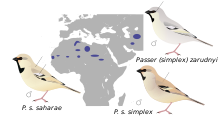Desert sparrow
| Desert sparrow | |
|---|---|
 |
|
|
Not recognized (IUCN 3.1)
|
|
| Scientific classification | |
| Kingdom: | Animalia |
| Phylum: | Chordata |
| Class: | Aves |
| Order: | Passeriformes |
| Suborder: | Passeri |
| Infraorder: | Passerida |
| Superfamily: | Passeroidea |
| Family: | Passeridae |
| Genus: | Passer |
| Species: | P. simplex |
| Binomial name | |
|
Passer simplex (Lichtenstein, 1823) |
|
 |
|
| The three subspecies of desert sparrow | |
The desert sparrow (Passer simplex) is a bird of the sparrow family Passeridae, found in the Sahara Desert, Central Asia, and Iran.
Two subspecies occur in some of driest parts of the Sahara Desert in northern Africa, and a distinct subspecies occurs in areas of Iran, Turkmenistan, and Uzbekistan. The Asian subspecies may be a separate species, and is called the Asian desert sparrow or Zarudny's sparrow (Passer simplex zarudnyi). According to Guy Kirwan and colleagues, the Asian birds are separate under any definitions of species except the biological species concept.BirdLife International, and therefore the IUCN Red List, recognise both species.
The desert sparrow is not afraid to come near humans and sometimes builds nests in muddy walls. The Mozabite Berbers build their homes with holes in the walls to welcome these birds, which they call "bar-rode", and if one sings all day in the house, they say this is a sign of good news. The Tuareg, who call the bird "moula-moula", also say that this bird brings good news when it comes to stay near the camp.
This bird is becoming scarcer as a result of habitat destruction. The IUCN Red List nonetheless classifies both species it recognises as being of least concern for conservation, as it did before the split was recognised.
A pair of the subspecies P. s. saharae near Benichab, Mauritania
Eggs of Passer simplex saharae from the collections of the MHNT
...
Wikipedia
